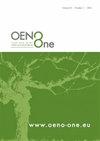Effect of microwave treatment for wine microbial stabilisation: Potential use of a Weibullian mathematical model
IF 2.2
3区 农林科学
Q3 FOOD SCIENCE & TECHNOLOGY
引用次数: 0
Abstract
The aim of this research was to investigate the efficiency of microwaves (MW) for wine microbiological stabilization and thereby assess the potential application of a Weibullian mathematical model in wine industry. The study focused on (i) the influence of treatment time (come-up time and temperature maintenance) and temperature on a simple wine-like matrix, as well as (ii) the specific resistance of yeast and bacteria selected according to their representativeness in red wines (A. aceti ATCC_15973, S. cerevisiae FX10, B. bruxellensis CRBO_L0619 and AWRI_1499), and finally (iii) the potential usefulness of a new mathematical model adapted to heat treatment to evaluate strain sensitivity. This research aimed to show that microwave treatment decreases the main wine-associated microorganism populations and that the reduction in viable counts mainly depends on the MW treatment temperature. Complete microbiological stabilisation was obtained under a temperature of 50 °C a very short treatment time, except in the case of A. aceti ATCC_15973. Furthermore, the Weibull parameters analyses showed that heat inactivation a wine microorganism studied did not follow first-order kinetics, indicating that we should change our way of studying thermal death curves. The findings from this study suggest that MW could be useful for the wine industry as a complement or an alternative to sulphite utilisation.微波处理对葡萄酒微生物稳定的影响:Weiburlian数学模型的潜在用途
本研究的目的是研究微波(MW)对葡萄酒微生物稳定的效率,从而评估威布尔数学模型在葡萄酒工业中的潜在应用。该研究集中于(i)处理时间(出现时间和温度维持)和温度对简单的葡萄酒样基质的影响,以及(ii)根据其在红葡萄酒中的代表性选择的酵母和细菌的特异性抗性(a.aceti ATCC_15973、酿酒酵母FX10、B.bruxellensis CRBO_L0619和AWRI_1499),最后(iii)适用于热处理的新数学模型评估应变敏感性的潜在有用性。这项研究旨在表明,微波处理减少了与葡萄酒相关的主要微生物种群,活菌数的减少主要取决于微波处理温度。在50°C的温度下,在极短的处理时间内获得了完全的微生物稳定,但a.aceti ATCC_15973除外。此外,威布尔参数分析表明,所研究的葡萄酒微生物的热灭活不遵循一级动力学,这表明我们应该改变研究热死亡曲线的方法。这项研究的结果表明,MW可以作为亚硫酸盐利用的补充或替代品,对葡萄酒行业有用。
本文章由计算机程序翻译,如有差异,请以英文原文为准。
求助全文
约1分钟内获得全文
求助全文
来源期刊

OENO One
Agricultural and Biological Sciences-Food Science
CiteScore
4.40
自引率
13.80%
发文量
85
审稿时长
13 weeks
期刊介绍:
OENO One is a peer-reviewed journal that publishes original research, reviews, mini-reviews, short communications, perspectives and spotlights in the areas of viticulture, grapevine physiology, genomics and genetics, oenology, winemaking technology and processes, wine chemistry and quality, analytical chemistry, microbiology, sensory and consumer sciences, safety and health. OENO One belongs to the International Viticulture and Enology Society - IVES, an academic association dedicated to viticulture and enology.
 求助内容:
求助内容: 应助结果提醒方式:
应助结果提醒方式:


